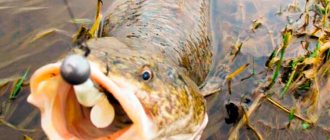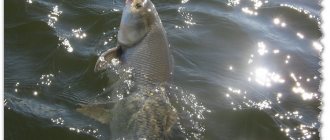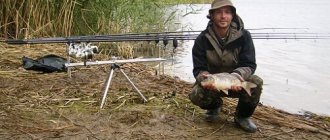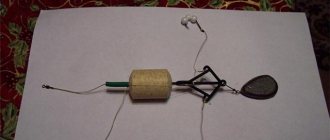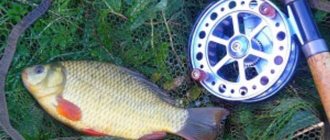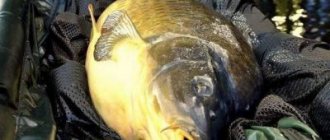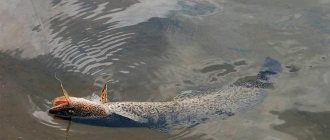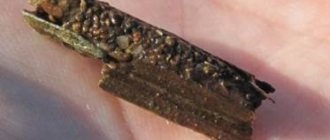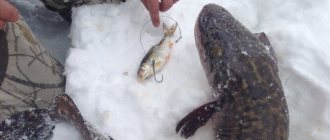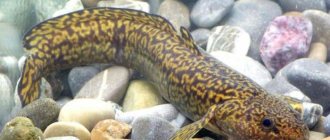Favorite time of burbot
Fishing for burbot in October begins as soon as the sun disappears behind the horizon and dusk sets in. This fish is far from shy. On the contrary, it happens that he swims to the noise and light of fires, which are specially burned to attract his attention. But during daylight hours it is almost impossible to catch it. He hides in shelter, under snags, in holes.
The most interesting thing is that burbot loves bad weather. It has long been noted that the worse the weather, the greater the chances of his capture. I don’t care about rain, sleet or chilly wind. He hunts at the bottom, waiting for confused small fish, picking up snails and sometimes waste. Burbot is considered the orderly of reservoirs, and he fully deserves this title.
Autumn burbot fishing on the Irtysh
> What to catch > Burbot > Autumn burbot fishing on the Irtysh
Burbot fishing
is deservedly popular among many anglers. Many people know that burbot fish soup is a real delicacy and appreciate this fish. Large individuals, as a rule, are found mainly in the rivers of the North and Siberia, and try to stay in deserted places. The peak of burbot activity occurs during the most difficult time for fishing.
Burbot fishing in September
Autumn burbot fishing in the Irtysh,
in the vicinity of Tobolsk occurs mainly slightly below the confluence of the Irtysh and Tobol rivers. At the height of autumn, which begins already in mid-September in these places, most of the fish living in the Irtysh lose their activity, but burbot, on the contrary, only gains activity at this time. It becomes much more mobile and comes close to the shore. It is at this time that the chances of his capture increase many times over.
The most active autumn fishing for burbot in the Irtysh River
, as a rule, occurs in the dark. During the open water season, burbot is caught using hooks, or putts in other words. In this case, the bait is put on a hook by the lips and thrown into the river all night. Zherlitsy are used very rarely.
The gear used by local fishermen is very simple, and as practice shows, castings are much more effective than anchored circles or girders. It’s all about the current of rising water, which causes branches, leaves and other debris, and the habit of burbot to tangle a long fishing line, putting the stands in a more advantageous position in comparison with the girders and circles.
In the autumn, as mentioned above, burbot comes close to the shore and moves along it. It enters the smallest bays and creeks, the mouths of rivers, rivers, and streams flowing into the Irtysh. That is, these are the places where there are a lot of small fish that burbot feed on.
In September, burbot begins to actively hunt; burbot biting is especially active on moonless nights. It has long been noted that the worse the weather, the better the burbot bite. Autumn burbot fishing in the Irtysh River
ends when freeze-up begins and after the ice has formed,
winter burbot fishing
. Active biting of burbot lasts until its spawning. After spawning, this fish again begins to actively feed, and bites until the end of April. Burbot activity decreases during periods of intense ice melting and resumes during flood periods.
The favorite bait for burbot is considered to be ruff, gudgeon, chicken entrails, liver, and meat. Many fishermen consider the ruff to be a special gastronomic predilection for burbot.
They prefer to catch burbot using a dead ruff; some fishermen trample the ruff with a boot to enhance the smell and only then hook it on the hook.
Autumn burbot fishing in the Irtysh River requires the use of strong, reliable gear. Since burbot often drags the tackle into snags or other hard-to-reach places, places from where it is difficult to remove it. Therefore, even leashes on a throw are installed from fishing line with a thickness of at least 0.5 mm, and the base must have a cross-section of at least 0.8 mm. After all, pulling out a burbot weighing 4-6 kg, huddled between snags, is not an easy task.
The sinker has a flat shape and can slide freely along the fishing line; the weight of the sinker depends on the strength of the current in the places where burbot is caught. The hooks are equipped with hooks No. 7-10, sometimes larger ones. Catching burbot in the fall
with a cast
, occurs from the bottom, while trying not to leave a free fishing line. Burbot swallows the bait completely, and if there is a decent amount of slack, the first thing after biting is to rush under stones or into snags.
There is no need to hook the burbot; it always swallows the bait completely. Burbot hooks are not taken out when fishing, the leash is cut off and a new one is installed. And the old one is removed at home. Usually, when going fishing, an angler stocks up with a sufficient number of spare leashes with hooks.
They catch burbot at night, sometimes the biting activity decreases for 2 or 3 hours, and sometimes it can bite well throughout the night. Successful catching of burbot in the fall depends on how correctly the angler has identified the places of movement of the burbot. Usually you need to look for burbot trails near the shore. Such paths are defined by donks, they are placed in a checkerboard pattern, and thus block a section of the river that has different depths.
Burbot fishing in October
October is the best time to catch burbot in the fall. The nights at this time are cold and long, the weather is windy and it often rains. This is exactly what is required for successful burbot fishing. Fishing for burbot in the Irtysh in autumn
, in October, always pleases with good catches of this fish.
In October, burbot fishing begins after sunset, at dusk. Burbot fish are far from shy and very curious. He is not frightened by the noise on the shore and the fire of the fire, but on the contrary, he is attracted. Fishermen specially light fires on the shore to attract curious fish closer to the shore. But during the day there is no point in catching burbot with a bait; it won’t bite. At this time he prefers to be somewhere, not in a shelter.
As mentioned earlier, burbot are especially active in inclement weather. Wind, drizzling cold rain, or snow and sleet are the best times to catch it.
Burbot hunts at the very bottom; in bad weather, many fish get sick and become passive. This allows the burbot, without spending much effort, to feed on small fish that are half asleep.
As in September, in October burbot are caught using hooks; as a rule, fishermen set up 10 or more gears and then go to rest. In the morning they check the gear and count the catch. Usually, the burbot sits tightly on the hook; escapes are extremely rare, because it swallows the bait deeply. However, this method of catching burbot cannot be called practical. If the fish were taken out of the water after the bite and new bait was installed, the catches would be much more significant. At the same time, prey brought to the shore in time will not be able to get caught in stones or snags and will not confuse the fishing line.
Autumn burbot fishing in the Irtysh
, of course, has its difficulties and only the most persistent and patient achieve good catches.
Where to look for burbot in the fall?
Autumn fishing for burbot
on rivers such as the Irtysh, Kama, Ob, it has its own difficulties in that sometimes it takes a long time to find sites for this fish. Especially if the places where fishing is planned are little known to the fisherman.
Burbot has special territorial preferences. Most often, burbot prefers to be in places where there is great depth, near reaches and cliffs. It is often concentrated at the mouths of small rivers and streams flowing into a large river. There, burbot will stay either in shallow water at the confluence of rivers or in the tributary itself.
Burbot likes to be in places where there is a rocky bottom; at night, it comes out to riffles and shallow areas. Small and medium-sized burbot prefers to stay in places where weak currents prevail. Large specimens, as a rule, tend to be in deep areas of the reservoir.
Exciting autumn burbot fishing in the Irtysh
, this is an excellent opportunity to experience the romance of night fishing and be alone with nature.
Happy fishing!
Published: 10/23/2018
Other interesting materials:
| Various methods of summer catching bersh in the sea When the bersh begins the spawning period, it practically stops... | Problems with licenses of Astrakhan fishermen March 20, 2014 Astrakhan is the land of watermelons, tomatoes and fish wealth. Fish… | Dory fish with oranges There is such a fish, it has tender and juicy meat, its color is pinkish-cream…. | Sea fishing in Mozambique In terms of fishing, Mozambique is a unique country, a real... |
How to catch burbot in the fall
In October, burbot fishing is carried out using bottom gear. Many fishermen place about 10 or even more bottoms on the shore and go to bed. And in the morning they return and evaluate their catch. As a rule, practically no escapes are observed, because the fish swallows the bait deeply. But this method is ineffective, because one tackle will only bring one trophy. But if the burbot had been caught in time and made another cast, the catch would have undoubtedly increased. And a fish delivered to the shore on time guarantees that it will not go into shelter and will not wrap the fishing line around snags.
But still, most anglers prefer to participate in the fishing process. They sit on the shore, warming themselves by the fire, and wait for the frisky ringing of bells, signaling a bite. Fishing for burbot is a harsh romance. And only the most persistent achieve good success.
Tackle for burbot
So, burbot fishing in October is carried out using bottom tackle. This is the most productive method. Donka can be the simplest without a rod with a fishing line wound on a reel. But such tackle is not very convenient when fishing. It is better to use a donkey with a fishing rod. This can be a short spinning rod; it will also work well with a broken tip. Every fisherman has a broken fishing rod, and probably more than one. A strong multiplier or spinning reel with a good spool capacity is installed on it, onto which ordinary fishing line with a diameter of 0.3 - 0.35 mm is wound. A sinker (weighing at least 100 g) is tied at the end. One hook is installed. It could be a little doppelgänger. In general, the hook is selected in accordance with the bait used, and also based on the weight of the expected trophy.
Making a do-it-yourself snack
You can see how to make your own gear for catching burbot in the following video. You can make sure that this is really simple tackle that can be made in just a few minutes; you just need to purchase the necessary components in the form of fishing line, sinker and hooks. If someone prefers a reel, then the tackle is also budget-friendly, since you don’t have to spend money on a rod and reel.
Catching burbot in the fall is not an easy task, since the temperature of the water and the environment creates a certain level of discomfort, but the colder it is outside for a person, the more favorable it is for burbot.
Where can you find burbot in the fall?
Catching burbot in October on the Oka, Kama, and Irtysh is complicated by the fact that you have to look for sites for this fish. It is especially difficult if the body of water is unknown. So, burbot is a fish of special territorial preferences. Will stay in areas near cliffs and reaches with great depths. It is quite often found in areas where small tributaries and streams flow into rivers. Burbot here will be either in the inflowing river itself, or in shallow water at the confluence. You also need to pay attention to the nature of the bottom. Burbot prefers rocky soil. At night it rushes to shallows and riffles. Large specimens need to be looked for at depth, small ones stick to areas with weak currents.
Search for a place
In any case, the success of catching burbot in October directly depends on the choice of location, so before going fishing you need to carefully examine the reservoir, identifying promising areas. If you manage to find a fish site, then a successful bite is guaranteed. This predator prefers to stick to its favorite routes and almost never changes them.
Burbot prefer areas with a rocky bottom without silt or mud. At night, it goes to the rifts, while the largest representatives of the species try to stay at the deepest points. If fishing is carried out on a reservoir, a pre-channel table can be a good place for casting.
Burbot are also attracted to snags or other shelters. When fishing on a river with a moderate current, it is best to look for it in places with a relief, rocky or sandy bottom.
[custom_ads_shortcode2]
Bait for catching burbot in autumn
It doesn’t matter where burbot fishing takes place in October - on the Kama, Volga or Angara. These fish have the same habits and preferences. As bait for burbot, several worms are usually used, which are placed in a bunch on a hook. Not a single predator will swim past such bait. You can also use small fish. A small roach or small bream will do just fine. By the way, burbot will also not refuse a small crucian carp, half the size of your palm. Well, if all the available fish is too large, then you can cut it into pieces. This bait “works” a little worse than worms, but the predator still takes it well.
Fishing for burbot in October on the Volga and other large rivers is very good using pieces of chicken liver. Half a kilogram of this offal is enough for the whole night. A whole piece is placed on the hook. It should hold tight and not slip. Greedily grabbing the bait, the predator swallows it. The hook ends up deep in the stomach. Therefore, you need to prepare spare hooks and leashes in advance.
Burbot fishing tactics
So, in order to successfully catch burbot, you must first detect it in a reservoir, find its paths along which it regularly goes in search of food. Burbot moves around quite a lot during the night, so finding its routes won’t be too difficult, although it may take several fishing trips.
In order for the search for burbot to be as effective as possible, it is advisable to use several donks, at least three, and preferably at least five. Then you can immediately explore a large area of water and increase the chances of a bite.
Donks are thrown at a distance of at least 15-20 meters from each other and always at different distances from the shore - some closer, some further. If there were bites, it means there are burbot trails here and fishing in this place will bring results next time and in general, this place will remain promising for next fall.
If there were no bites from the burbot, it means either he doesn’t come out here in search of food, or he didn’t like something else - your bait, the chosen fishing time, or the weather was too warm. In this case, next time it is better to look for burbot in another promising place, and mark this as unsuitable for catching it.
The burbot bite is very interesting. The fish picks up your bait and begins to slowly absorb it, without moving from its place, which causes the bite alarm to not work. Only after swallowing the bait well does the burbot begin to move to the side, while its bite looks quite powerful.
Due to such a bite, the fisherman regularly encounters the fact that the hook ends up in the burbot’s stomach and it is impossible to remove it directly while fishing. Therefore, most often, catching burbot ends with the angler having to cut the leash and then tie a new hook.
Burbot is an excellent trophy and catching it in October on a donk is a very good time to start the opening of the autumn burbot fishing season. Further, as winter approaches, the burbot bite will only improve. Well, since you are now armed with the knowledge that the site rybkolov.ru gave you, you can easily cope with catching it and will definitely achieve success in this matter. And as a token of gratitude to the site, you can leave your comments. No tail, no scales.
Catching burbot in October using a “snitch”
Burbot feeds in conditions of extremely limited visibility. Therefore, he does not rely on his vision. He uses other senses. When hunting, burbot relies on smell, touch and, of course, hearing. The tackle used by fishermen should have an irritating effect on him and arouse interest. This is easily used by residents of Transbaikalia, who regularly catch burbot using a “snitch” from a boat.
A “squealer” is a spoon, they are not available for sale, so fishermen make them by hand. The tactics for catching this lure are simple. A fisherman from a boat slowly sinks it to the bottom, then lifts it 20 cm and lowers it again so that it hits the ground. The “snitch” is made of metal. In addition, an iron ring is installed on it, which rings when struck. The “squealer” is most often used on a rocky bottom; if the ground is covered with a layer of silt, then such tackle becomes useless. Catching burbot in October using a “snitch” is a very labor-intensive process; this method is more suitable for the winter period.
